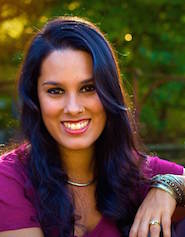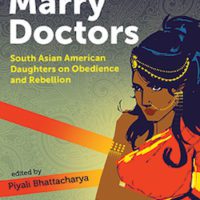“In their eyes, it will never be complete. I will never be complete.” – Phiroozeh Petigara
Good Girls Marry Doctors is Piyali Bhattacharya’s decade-long labor of love to bring together the stories of 27 South Asian American women in one searing essay collection. The subtitle says it all: “South Asian American Daughters on Obedience and Rebellion.” The authors’ families hail from Sri Lanka, Bangladesh, India, and Pakistan, with Hindu, Zoroastrian, Buddhist, and Muslim backgrounds. They have all landed, as the wry essay “Fair Game” by Madiha Bhatti puts it, somewhere in “the land of the melanin-free and tanning bed brave.”
One of the major themes of the anthology was of course the be-all-end-all goal of marriage (to a person of the opposite sex, not to mention the same culture, caste, and religion). It goes without saying that even when marriage wasn’t mentioned, it was likely in the backdrop of many of the stories. Neelanjana Banerjee’s lovely intimate essay “The Photograph of My Parents” describes her parents’ divorce that leaves her mother heartbroken, and yet somehow eventually inspires Neela’s own marriage. The potential and multitudinous beginnings hinted at in an old photograph are the striations of real life. It’s not illusion or perfection that grounds a stable companionship, but something far more complicated and fragile.
Another essay written on the themes of marriage and love, “Patti Smith in the Dark” by Jyothi Natarajan hit home and hard. Like me and my sister, she and her sister have struggled with the patriarchal structures underlying marriage and wifedom. In Jyothi’s family’s case, sexuality (her sister is gay) makes the good daughter/bad daughter polemic that much more complicated. I was in tears by the end of her tender and assured essay, and I was braver too. There’s something about knowing someone else has been through what you have (in some or any fashion) that makes you not feel not so crazy, selfish, ungrateful, rude, unreasonable, political, brazen, and all the other things that we’re often accused of—not just the South Asian daughters, but the immigrant daughters. Not just the immigrant daughters, but all daughters. We know this as women. The pressures of conforming are enormous, fatal even.
Piyali’s introduction to “Good Girls Marry Doctors” points to the pain of all this honesty, the vulnerability, the defiance and destructiveness. Daughters have a particular and encompassing role in traditional cultures and it can stifle any sense of individuality, let alone ambition or happiness. The seemingly simple idea of choosing “what being Indian means to me” as Surya Kundu puts it, can look like a betrayal of tradition and family.
I was immensely moved by the stories of queer women, as these narrators had not only the weight of worldly disapproval that comes with falling outside heteronormativity, but family reactions that ranged from bewilderment to outright abuse and rejection from their families and communities. In the essay “The Day I Found Out I Was a Witch,” Fawzia Mirza is told by her mother that she’s possessed by the devil when she comes out to her parents, and she slowly transforms that curse into something surreal and striking: a coming into her witching powers. And she painfully learns the limits of family loyalty: “If you can’t love me, I have to go.”
Hema Sarang-Sieminski’s essay “Amma” is a terrifying tale of incestuous abuse and epic emotional manipulation. She is so trapped by her mother’s injunctions that she finds a gay boy to marry so as to hide and/or normalise her relationship with her partner. As with many cases of abuse, parental and otherwise, nothing she does is enough, and it’s only with time and therapy that she finds a way to heal.
I enjoyed how many of the stories wove in references to Hindu mythologies, breathing new life into the ancient stories. In “Draupadi Walks Alone at Night,” SJ Sindu interleaves a story from the Mahabharata with her own life, but she wants Draupadi’s fate rewritten, and thus perhaps her own as well, a life where her coming out isn’t ignored or rejected. “Modern Mythologies” by Surya Kundu starts with the story of Sita, by all accounts, a good wife, but it’s the incendiary goddesses Durga and Kali who show her a way to reconcile the lot of women with what they actually want or deserve. In “Good Girls Pray to God,” Triveni Gandhi’s love of Hindu stories and the desire to be a good girl still leads to a conflicted restless identity. It’s a widening of her social spheres, traveling through India’s countryside and falling in love that she finds a looser, more loving, and internal face of god: “I had to be kind to myself and the God within me.”

In “Without Shame,” Ayesha Mattu is initially silenced by her strict Muslim parents, but finds her voice while working with child survivors of sexual abuse in Pakistan. It’s only after she gets married that her mother is able to open up to her. And Ayesha is determined to raise her own children with abiding love, kindness, and what she calls sex-positive Islam: “Foreplay is sunnah, orgasm a Muslim wife’s right.”
The dynamics of family communications and community acceptance were frequent themes in the anthology. Nayomi Munaweera’s essay “The Only Dates Are the Ones You Eat” is a clear-headed, brutally honest treatise on “the powerful threat of contagion posed by Americanization.” She describes how local communities, old country politics, and history can reverberate in one’s own life, forcing you to choose between societal approval and your own pleasure and story. And how ingrained this conditioning can be, how damaging: “I had labeled myself slut. I had done this unconsciously, thoroughly.”
“What It Looks Like to Grow” by Ankita Rao is a thoughtful nuanced essay about losing oneself despite what looks like an open warm family life from the outside. She develops anorexia at age 14 and it takes years of suffering and eventually therapy to understand what’s happening and how to deal with it, writing, “All of us had allowed this part of ourselves to go undeveloped, the part of us that didn’t know how to express what we were going through, allowing that pain and anger to culture and spread until some sort of implosion.”
Luckily, Ankita’s story resolves with a kind of emotional holy grail for many South Asian families: “My family have become the kind of people who talk about feelings. We ask questions when we know something is missing in the silence.”
But the anthology’s themes were not all traditional. There were families that sought to transcend stereotypes and cultural norms, many of which involved mothers. For example, in “My Mother, the Rebel,” Jabeen Akhtar’s mother goes vegetarian with a vengeance, hauling her family into the fraught world of animal rights activism and causing Jabeen to despair of ever rebelling with a mother this progressive. In “Good Girls Become Doctors,” Sayantani DasGupta’s mother is a feminist who establishes the first anti-violence women’s group in the South Asian American community. In “Subterfuge,” Tara Dorabji’s grandmother rewrites her own history by divorcing, losing custody of her children, and remarrying (a white man), and when Tara’s own parents divorce, her mother joins a support group.
“Becoming a Reluctant Breadwinner” is Swati Khurana’s brave and vulnerable essay about vaginismus, pregnancy, and how it feels to diverge from the rescue narrative that often defines the lives of Desi women. Her parents are supportive throughout, and in turn, she echoes a sentiment in Tara’s essay mentioned above, about wanting one’s children to be free to be flawed, free to be true to themselves. In “Acting the Part,” both of Rachna Khatau’s parents champion her choices and her performing career—something that she might not realize is a rare and wondrous thing in any community, immigrant, South Asian, or other.
It’s difficult to describe all the essays in an anthology, especially when the themes are so varied, from the grief of losing a parent, to not wanting children, or being unable to have them, to the stifling legacy of student debt, to the simple desire to create one’s own life. I didn’t realize that at the age of 43, I would find this book quite so heart-stoppingly resonant. Then again, it’s never too late to revel in representation. It’s not often that brown girls in America get to see themselves in writing, and I have long been aware of the trials of invisibility. But it was still surprising to me how overjoyed I was to be spoken for. Part of it is as Piyali says: “For the women who have written for [this anthology], this represents the breaking of a long and deep silence.”




